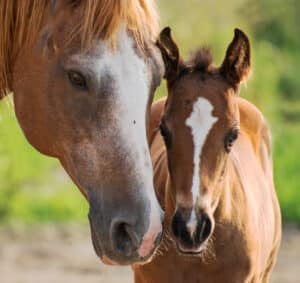Vaccinations are a vital part of you horse’s health care – and there’re many good reasons to keep them up to date, as DR DOUG ENGLISH explains.
Equine vaccines play a critical role in protecting horses from various infectious diseases. The biochemistry of each vaccine can vary based on the type of pathogen being targeted and the vaccine technology used – but the goal of all vaccines is to stimulate the horse’s immune system to recognise and remember the pathogen, providing protection against future infections.
While vaccines can produce a fever and some malaise which may be detected or pass unobserved, they nonetheless protect against diseases which have high morbidity and fatality. Horses die every day for many reasons and sometimes there is an opinion that if a vaccine was recently given, then that was the cause. I have never in my 50 years of practice seen a death that I considered was related to a vaccine. However, I have seen a few horses that got a bit sicker than is normal from a vaccine reaction, and their frightened owners have mistakenly thought it was a near death situation!
Inactivated Vaccines
Inactivated vaccines, also known as killed vaccines, are created by inactivating the pathogen (virus or bacteria) using chemicals, heat, or radiation. The inactivated pathogen retains its structure but is no longer capable of causing disease. These vaccines usually contain the whole or fragmented pathogen and are often combined with an adjuvant, an important component of many vaccines added to enhance and modulate the immune response generated by the vaccine’s antigens.
Adjuvants, which improve the effectiveness of the immune response, resulting in a stronger, longer-lasting, and more robust immunity, are carefully regulated and studied to ensure both safety and effectiveness.
Biochemistry: Inactivated vaccines contain proteins and other molecules present on the surface of the pathogen, including antigens that can trigger an immune response by stimulating the immune system to produce antibodies against the pathogen. When the horse encounters the actual pathogen, the antibodies can recognise and neutralise it. Examples of inactivated vaccines include:
- Duvaxyn EHV 1,4
A herpes virus vaccine recommended for healthy horses and ponies from five months of age to reduce the clinical signs of the respiratory diseases caused by EHV-1 and EHV-4.
Primary course: A single dose of Duvaxyn EHV1,4 should be administered from five months of age followed by a second injection after an interval of 4-6 weeks.
Boosting immunity: After the primary course, a single dose of Duvaxyn EHV1,4 should be administered every six months.
Control of abortion: To aid in the control of EHV-1 abortion (when used in conjunction with appropriate management practices) pregnant mares that have been previously primed should be vaccinated during the 5th, 7th and 9th months of pregnancy with a single dose on each occasion. Note: Pregnant mares vaccinated with this product may still abort, but significantly fewer.

- Duvaxyn R (Rotavirus)
An adjuvanted vaccine for pregnant mares designed to stimulate the production of Equine Rotavirus antibodies. The passive transfer of these antibodies in colostrum and milk helps to reduce the foal’s risk of diarrhoea caused by Equine Rotavirus.
Dose: Administer 1 mL intramuscularly in the 8th, 9th and 10th months of pregnancy using an aseptic technique. A yearly booster dose should be given one month prior to foaling for each subsequent pregnancy.
- Equivac EST (Salmonella) Vaccine
An inactivated adjuvanted vaccine for the immunisation of mares and foals to aid in the control of diseases caused by the bacteria Salmonella typhimurium, which are disorders such as diarrhoea, septicaemia and polyarthritis.
Dose: Two doses of the vaccine four weeks apart are required to produce an adequate response, and annual boosters to brood mares to provide passive protection for foals.
- Rabies Vaccine
Because rabies is not in Australia, the vaccine is not generally available here. Rabies is a viral disease that affects mammals, including horses.
- Eastern/Western Equine Encephalo-myelitis (EEE, WEE) Vaccine
Commonly vaccinated against in the USA but currently not in Australia
Live Attenuated Vaccines
These vaccines use weakened forms of the pathogen that have been cultured under conditions that reduce their capacity to cause disease, while maintaining their ability to stimulate an immune response.
Biochemistry: Live attenuated vaccines contain pathogenic organisms that have undergone genetic mutations or adaptations. These changes might affect critical genes required for the pathogen’s virulence. The horse’s immune system responds to these attenuated pathogens, generating both cellular and humoral immune responses. These vaccines often provide strong and long-lasting immunity. Examples include:
- Equine Influenza Vaccine
Caused by influenza viruses, the disease is not now in Australia and vaccination is neither available nor allowed. Either an inactivated or Modified Live Vaccine (MLV) type, both provide protection against this respiratory disease.
Subunit Vaccines
Rather than the entire organism, subunit vaccines contain only specific antigens from the pathogen, such as proteins, polysaccharides, or other molecules critical for the pathogen’s ability to infect the host.
Biochemistry: Composed of purified antigens selected to stimulate a targeted immune response, these antigens are often produced through recombinant DNA technology, protein expression, or other biochemical processes. The immune system recognises the antigens and produces antibodies against them, providing immunity without the risk of causing disease. Examples include:
- Equine strangles Vaccine
Vaccines such as Equivac S stimulate the immune system to produce antibodies intended to provide protection against Streptococcus equi bacteria. Equivac S vaccinates against strangles alone, Equivac 2 in 1 vaccinates against both tetanus and strangles.
Dose: As an example, the primary vaccination program may include a first dose of Equivac 2 in 1, a second dose of Equivac S, and a third dose of Equivac 2 in 1, where the interval between each dose is not less than 2 weeks.
An optimal strangles vaccination booster program for young susceptible horses involves boosters given every 6 months. Equivac 2 in 1 could be administered annually, with Equivac S administered mid-way between annual Equivac 2 in 1 doses. Older horses are not as susceptible, but an annual (or at the least biannual) booster for both tetanus and strangles is good practice.
- Equivac HEV (Hendra) Vaccine
An adjuvanted vaccine that contains 100g/mL of recombinant Hendra virus G glycoprotein as the only active constituent, and recommended for all horses four months of age and older.
Dose: Two primary doses 3 to 6 weeks apart. A 3rd dose 6 months after the second primary dose is required, with further boosters administered every 12 months after the 3rd dose. All doses must be entered into an online registry within two days of administration. Foals born to vaccinated mares should commence vaccination at 6 months of age. Pregnant mares are not to be vaccinated during the first 6 weeks after conception or 2 weeks prior to the expected foaling date.
Recombinant Vaccines
These involve genetic engineering techniques to produce pathogen-specific proteins, which can then be used as antigens to stimulate an immune response.
Biochemistry: Using DNA technology, specific genes from the pathogen are inserted into a harmless vector (like a virus) or host cell. The host cell produces the antigenic proteins, which are harvested and purified for use in vaccines. The immune response generated by these vaccines is similar to that of subunit vaccines. An example of a recombinant vaccine is:
- West Nile virus/Kunjin Disease Vaccine
Found in parts of Australia, particularly the Northern Territory and northern Western Australia, and detected in regional Victoria. However, it is considered rare with 43 cases reported throughout Australia since 1991 and only two cases reported in Victoria since 2010. This vaccine is rarely used in Australia and difficult to get, although commonly used in parts of the USA.
Toxoid Vaccines
Tetanus prone wounds are deep, dirty, and penetrating, like stake wounds or dog bites.
These vaccines target toxins produced by certain bacteria.
Biochemistry: Toxoid vaccines involve the chemical treatment (usually formalin) of bacterial toxins to eliminate their harmful effects while preserving their antigenic properties and maintaining their ability to stimulate an immune response. The immune system generates antibodies against these toxoids, providing immunity against diseases caused by toxin-producing bacteria. Examples include:
- Tetanus Toxoid (eg Equivac T) Vaccine
A vaccine containing the formalinised toxin of Clostridium tetani with an aluminium salt adjuvant. Thiomersal is added as a necessary preservative at 0.1 mg/ml. It contains ethylmercury, which, although concerns have been raised due to its toxicity, is less of a threat than the more toxic methylmercury found in certain seafood. Thiomersal has been used in vaccines for decades. Regulatory agencies such as the U.S. Food and Drug Administration and the World Health Organisation monitor and set guidelines for the use of thiomersal in vaccines. They assess the risks and benefits of using such preservatives and continually evaluate the safety of vaccines.
Tetanus toxoid is very effective against tetanus, and is often combined with strangles vaccine (as in Equivac 2 in 1) and administered as an intramuscular injection.
Dose: Tetanus prone wounds are deep, dirty, and penetrating, like stake wounds or dog bites. However, a single dose of Equivac T given to an unimmunised horse at the time of wounding or surgery may not prevent tetanus because it takes weeks for the body to react and produce enough antibodies. But if the horse has had a shot within the previous 5 to 10 years, the production of antibodies is instant.
If unsure of the horse’s status, active-passive protection with a combined dose of tetanus antitoxin and tetanus toxoid is useful. A separate needle and syringe should be used for each product and administration should be on opposite sides of the body. If initiating a primary course, the second dose of tetanus toxoid should be administered four to six weeks later.
Tetanus antitoxin is not really a vaccine. It’s the actual antibodies to tetanus toxin taken from the blood serum of immunised horses and purified and concentrated. It has an instant protective effect but a transient lifetime of only a few weeks.
Interestingly, infection with tetanus bacteria does not produce an antibody response to the toxin, which has to be modified to enable the immune system to recognise it. It’s always important to give a toxoid vaccination in all tetanus cases, as well as antitoxin.

This article was proudly sponsored by Apiam Animal Health. Apiam’s equine veterinary credentials are well-founded with a growing number of purpose-built dedicated Equine Vet Clinics and Referral Hospitals located in Victoria, New South Wales and Queensland, working alongside our network of mixed practice clinics in delivering quality equine veterinary care.
Find out more by visiting the Apiam Animal Health website apiam.com.au & view the equine product range on Country Vet Animal Supplies countryvet.com.au



